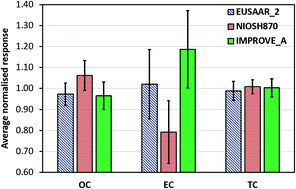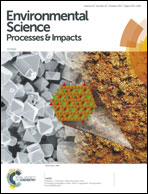Standardisation of a European measurement method for organic carbon and elemental carbon in ambient air: results of the field trial campaign and the determination of a measurement uncertainty and working range†
Abstract
The European Committee for Standardisation (CEN) Technical Committee 264 ‘Air Quality’ has recently produced a standard method for the measurements of organic carbon and elemental carbon in PM2.5 within its working group 35 in response to the requirements of European Directive 2008/50/EC. It is expected that this method will be used in future by all Member States making measurements of the carbonaceous content of PM2.5. This paper details the results of a laboratory and field measurement campaign and the statistical analysis performed to validate the standard method, assess its uncertainty and define its working range to provide clarity and confidence in the underpinning science for future users of the method. The statistical analysis showed that the expanded combined uncertainty for transmittance protocol measurements of OC, EC and TC is expected to be below 25%, at the 95% level of confidence, above filter loadings of 2 μg cm−2. An estimation of the detection limit of the method for total carbon was 2 μg cm−2. As a result of the laboratory and field measurement campaign the EUSAAR2 transmittance measurement protocol was chosen as the basis of the standard method EN 16909:2017.



 Please wait while we load your content...
Please wait while we load your content...